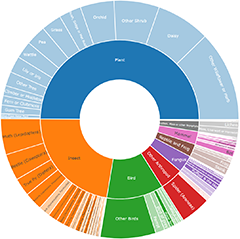Swift and Ghost moths (Hepialidae)
Announcements
5 May 2025
Hello NatureMaprsAs we move into the cooler months and sighting counts begin to wind down our team has been working tirelessly to ensure our platform’s usability and performance. All merch has been po...
Continue reading
Improvements to data import tool (coming soon)
NatureMapr welcomes Edgar McNamara
Platform wide attribute changes
New Feature: Moderator Quick Responses!
Discussion
donhe
wrote:
3 hrs ago
From Moths of Victoria Part 6 : "Oxycanus Identification" PDF on accompanying disc :
The wing patterns have variations within each species which exceed the differences between the species, so are of limited value.
The rami on the antennae differ.
O. australis males have long rami, length about 3x their spacing. O australis females have deeply corrugated antennae,
O. dirempta males have rami about as long as their spacing. O. dirempta females have barely corrugated antennae.
The wing patterns have variations within each species which exceed the differences between the species, so are of limited value.
The rami on the antennae differ.
O. australis males have long rami, length about 3x their spacing. O australis females have deeply corrugated antennae,
O. dirempta males have rami about as long as their spacing. O. dirempta females have barely corrugated antennae.
Oxycanus australis
DianneClarke
wrote:
Yesterday
@ibaird @donhe Seeking clarification on why you id'd this one as O. australis rather than O. dirempta. I wondered if the 2 markings below the lateral line was a important but I have just looked on BOLD and found this one https://bold-au.hobern.net/specimen.php?processid=ANICM760-10 which seems to have similar bumps below the lateral line. I find Oxycanus difficult.
Oxycanus australis
ibaird
wrote:
Yesterday
Male pectinate antennae light coloured asymmetrical with one side feathering much longer than the other.
Oxycanus antipoda
ibaird
wrote:
Yesterday
Oxycanus (male) with pectinate antennae, one side much longer thanthe other.
Oxycanus antipoda
Recent activity
Oxycanus (genus) at Rawson, VIC
Oxycanus beltista at Rawson, VIC
Top contributors
- jb2602 58
- kasiaaus 52
- AlisonMilton 47
- arjay 37
- WendyEM 36
- SteveBorkowskis 29
- HelenCross 24
- LisaH 22
- Hejor1 18
- Paul4K 17
Top moderators
- donhe 411
- ibaird 304
- GlennCocking 71
- DianneClarke 55
- MichaelMulvaney 36
- WendyEM 15
- JulieMorgan 13
- Bron 2
- kasiaaus 2
- WingsToWander 1




